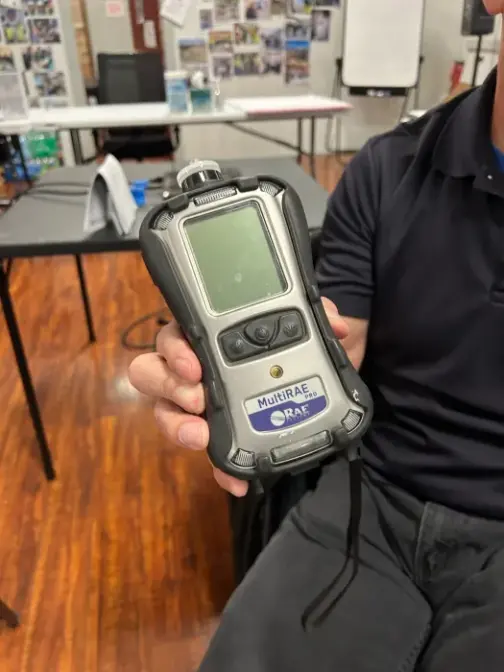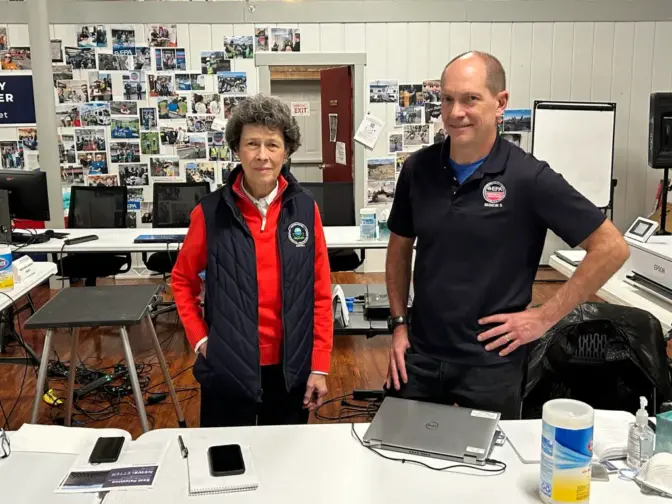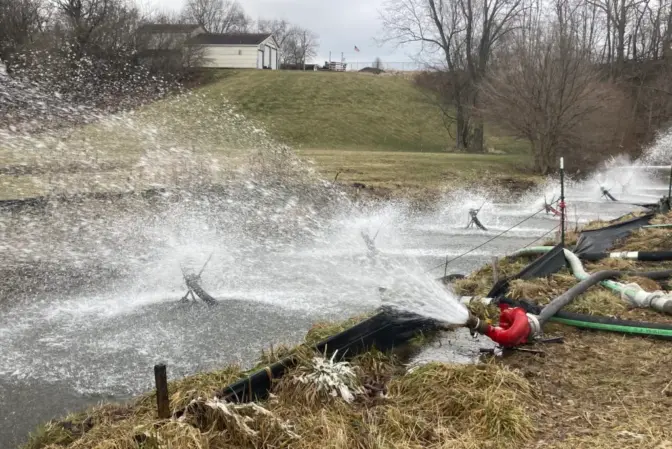
A Norfolk Southern train going through East Palestine on January 6, 2024, 11 months after one of its trains derailed there, setting off fires and chemical releases. Photo: Renee Rosensteel for The Allegheny Front


A Norfolk Southern train going through East Palestine on January 6, 2024, 11 months after one of its trains derailed there, setting off fires and chemical releases. Photo: Renee Rosensteel for The Allegheny Front

A Norfolk Southern train going through East Palestine on January 6, 2024, 11 months after one of its trains derailed there, setting off fires and chemical releases. Photo: Renee Rosensteel for The Allegheny Front
When Andrew Whelton first learned that Norfolk Southern would be burning off five rail cars worth of vinyl chloride that had derailed in East Palestine and that people would be allowed back into the town, he became alarmed.
“Whenever you know that there’s going to be a chemical incident, the release of vinyl chloride, there’s certain actions that you need to take to protect the population from harm,” said Whelton, a professor of civil, environmental and ecological engineering at Purdue University. “One of those is actually understanding what chemicals are produced and where they went.”
He became more concerned by statements from the EPA and other agencies that he worried were downplaying potential hazards.
“The creeks were heavily contaminated two miles downstream, and government statements were that actually the contamination was contained to the derailment site,” he said.
While Norfolk Southern is an obvious target for the ire of many in East Palestine, the EPA has also been criticized for its handling of the cleanup, as residents and workers have gotten sick in the months since. Those critics include Whelton, who has worked for months in East Palestine trying to assess the damage.
Whelton decided to come to East Palestine with members of his lab to sample drinking water shortly after the derailment. Whelton has consulted on other disasters – like a West Virginia chemical spill in 2014, wildfires and fuel spills.
He began to have more doubts about the EPA’s decision to allow residents back in when he learned the agency was relying on a piece of equipment called a photoionization detector (PID).
These handheld devices give a snapshot of chemical concentrations in the air. But they aren’t sensitive enough to detect relevant amounts of one chemical involved in the spill – butyl acrylate, a colorless gas that can target the eyes, skin, and respiratory system.
The EPA later admitted in a draft document obtained by E&E News and Politico they were not “sensitive enough” to measure butyl acrylate “at the public health air screening threshold for health and safety.”
“It is with that faulty information that the evacuation order was lifted. Residents and business owners were encouraged to go back into their contaminated buildings,” Whelton said.
“They should have tested correctly and applied the precautionary principle,” Whelton said, referring to the ecological tenet espoused by the naturalist Rachel Carson, which advocated proof that a product or environment was safe before allowing people to be exposed to it. “Will you make certain that the contamination is not present, or if it is, (that it) will not harm people?”

EPA response coordinator Mark Durno holds a photoionization detector. Photo: Reid R. Frazier / The Allegheny Front
Despite these issues, the PIDs were used to test over 600 buildings in East Palestine in February and March, according to the EPA.
In the weeks that followed, well after the evacuation order was lifted, residents reported symptoms like headache, nausea, and gastrointestinal problems. Even workers from the CDC got sick in East Palestine.
“It just underscores how unprepared the agencies were in executing the public health and safety response that they injured their own sister agency workers,” Whelton said.

Debra Shore, the EPA’s regional administrator, and Mark Durno, an EPA response coordinator for East Palestine, were in the EPA response center in East Palestine on January 23, 2024. They say the clean-up efforts followed sound science. Photo: Reid R. Frazier / The Allegheny Front
Mark Durno, a response coordinator for the EPA in East Palestine, said the agency used the devices to detect “emergency level” or “acute levels” of chemical concentrations, such as doses high enough to cause short-term or even life-threatening illnesses.
According to the EPA, “acceptable risk” is defined in federal emergency cleanup regulations as the “concentration level of a contaminant to which the human population, including sensitive subgroups, may be exposed without adverse effect during a lifetime or part of a lifetime.”
With butyl acrylate, some health impacts begin at 20 parts per billion, Durno said. But because the chemical is detectable by odor at much lower concentrations, he said a simple smell test was used to tell if a building was safe for return.
“The odors would have been so strong at 20 parts per billion…you wouldn’t be able to be in those buildings for more than a few minutes.”
The EPA and other agencies urged Norfolk Southern to offer temporary relocation money for people who wanted to leave during the cleanup, and the company did. Many took them up on it.
Debra Shore, the EPA Region 5 administrator, said the agency lifted the evacuation order because of the data coming in from what she calls an extensive and sophisticated air monitoring network the EPA had set up. The agency also used mobile air monitoring vehicles and some stationary “summa” canisters to characterize the air in East Palestine after the derailment.
“Why invite people back into the town? Because of the extensive and sophisticated and redundant monitoring of the air, we don’t have data that would show that exposure to the air in town is of at any level of chemical that would be of health concerns,” Shore said.
What about all those people who were having symptoms weeks and months after the derailment? Shore said it’s possible that they were more sensitive to chemicals than others sor that their symptoms were the result of stress and trauma.
“We know that people some people have chemical sensitivities that are far greater than others. And I think that there’s also true that people can have, sensitivities to various types of trauma that express themselves physically and may be layered over past histories of trauma and other incidents that this derailment triggered,” Shore said.
Whelton said he believes there were other problems with the response. He said agencies only tested for a limited number of chemicals when assessing local stream conditions.
“What you have to do is you have to go in and chemically fingerprint what you’re looking at.” He said there’s no evidence that agencies did do that.
This became a problem, he said, because the EPA later approved a plan to aerate the streams – literally have the water shot into the air, like a fountain, to speed up the breakdown of volatile chemicals.

Leslie Run in East Palestine is being aerated on March 13, 2023. The Feb. 3, 2023 train derailment contaminated streams that run through the town. Photo: Julie Grant/ Allegheny Front
“In order to determine if blowing it into the air and people inhaling it or getting it on their skin is safe, you need to know what chemicals they are,” he said. “So if you don’t know what chemicals they are, then you have no basis for claiming what the exposures are and are not safe.”
Durno of the EPA said workers doing the aerating wore pollution exposure badges and that the operation was monitored by OSHA to ensure its safety.
An EPA spokesman said in an email the “primary contaminants identified (in) the spilled material were petroleum-related compounds and, based on past and current data, the sheen is related to oil.”
The spokesman said that “(a)eration of surface water is a common and effective technique used in responses to impacted water bodies. Air samples in work zones and within the community, including locations near aeration operations, were analyzed for contaminants of concern and for a full spectrum of volatile organic chemicals and tentatively identified compounds. Air sampling best informs on community risk – not water sampling.”
Whelton said there is often a fog of war that local and even federal agencies fall under during a crisis and that these agencies simply aren’t prepared to respond to every contingency. But in many cases, they ask for outside help from academics and other experts. That didn’t happen here, he said.
“In East Palestine, all the agencies basically set up a bubble around themselves and kept Norfolk Southern and their contractors inside the bubble,” Whelton said.
The EPA defends their response. Shore said the EPA followed the science and the law. And she points out, no one died.
Durno admits that EPA could have done a better job communicating about potential chemical risks when it let people back into town.
“Instead of just making simple statements that it’s okay to go home, we should have given them more guidance on what that meant. Yeah. What did it mean to come home and, you know, experience some of these odors?” Durno said.
“That’s one of the things that we’ll take back, and we’ll analyze, moving forward, for the next one.”
StateImpact Pennsylvania is a collaboration among WITF, WHYY, and the Allegheny Front. Reporters Reid Frazier, Rachel McDevitt and Susan Phillips cover the commonwealth’s energy economy. Read their reports on this site, and hear them on public radio stations across Pennsylvania.
(listed by story count)
StateImpact Pennsylvania is a collaboration among WITF, WHYY, and the Allegheny Front. Reporters Reid Frazier, Rachel McDevitt and Susan Phillips cover the commonwealth’s energy economy. Read their reports on this site, and hear them on public radio stations across Pennsylvania.
Climate Solutions, a collaboration of news organizations, educational institutions and a theater company, uses engagement, education and storytelling to help central Pennsylvanians toward climate change literacy, resilience and adaptation. Our work will amplify how people are finding solutions to the challenges presented by a warming world.